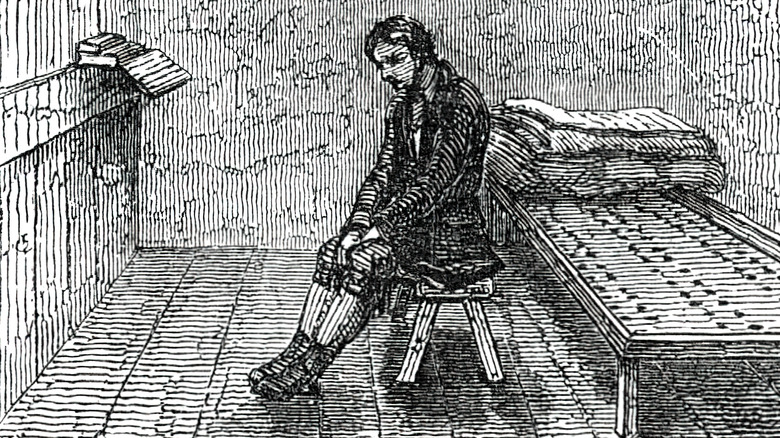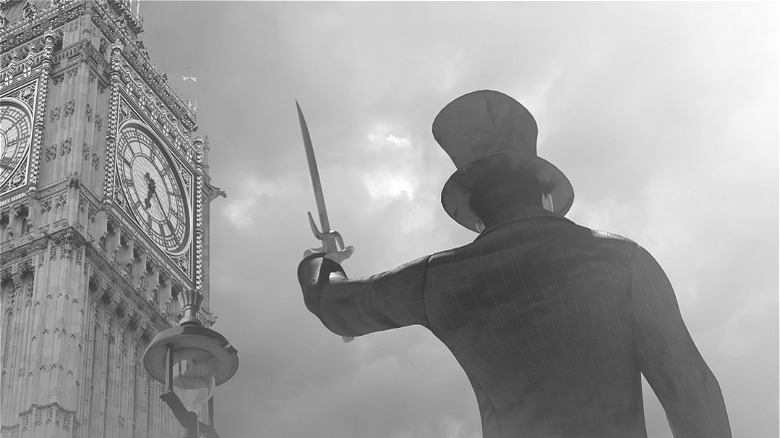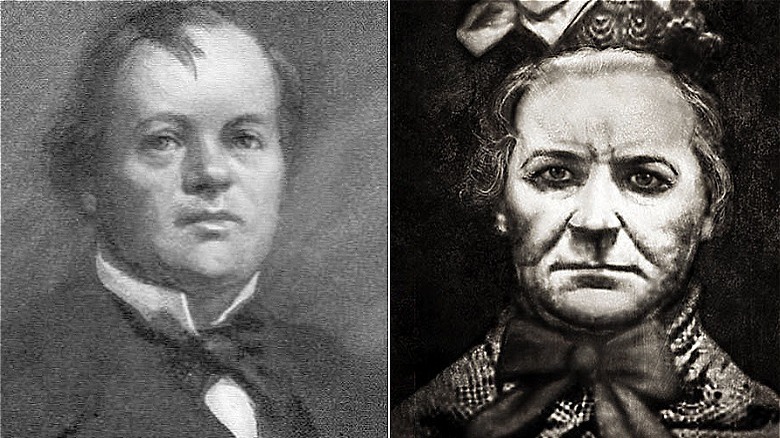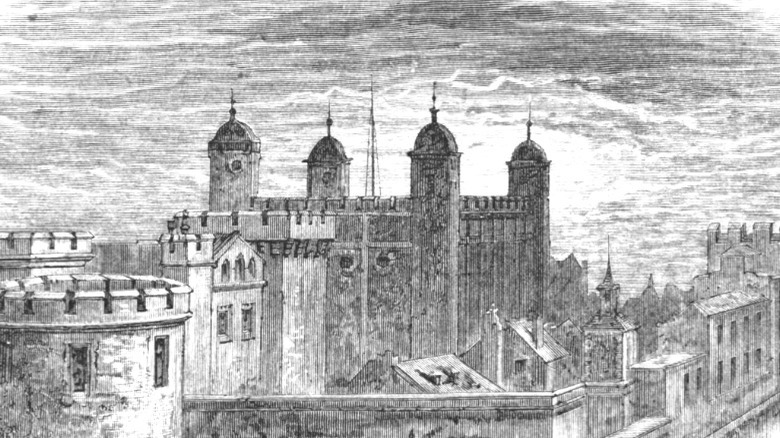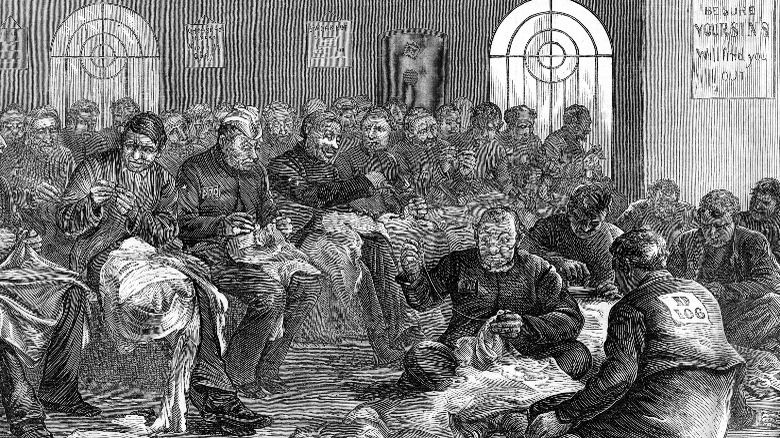What It Was Really Like For Criminals In Victorian England
According to LawTeacher, crime is defined as "an action or omission that constitutes an offense that may be prosecuted by the state and is punishable by law." As laws are a major part of the foundation of modern society, they generally need to be followed by the community to maintain order. Generally most folks seem to try to abide by a community's laws, but there are always those who don't follow the rules.
There are some pretty recognizable times throughout history where it appears that more crimes were taking place and things were a bit more chaotic. One such time was the Victorian era in England. Though this time period was one of progress and growth, there was also a rise in crime. As the level of crime rose, so did the need for ways to try to curb these unwanted behaviors. The Victorians then came up with many ways to punish those who were continuing to break the law.
Crimes in the Victorian Era
Though nearly two centuries have passed since the Victorian era, many of the same things are still considered criminal activity. According to The History Press, crime was truly on the rise during this time. You had some of your lesser crimes, such as theft, larceny and pickpocketing, but you also had more severe and violent crimes, such as murder.
Generally, the majority of crimes during this time were committed by young men, particularly petty theft. This isn't to say that women did not break the law, but they were more likely to be arrested for crimes related to sex work, drunkenness, and vagrancy, per Leicestershire Villages. The general rise in crimes is often attributed to the booming growth of industrialization. As cities became more industrialized, more people came to them to work. Due to this massive influx of people, you ultimately had more crime.
While many of the crimes were considered "victimless," there were obviously some that were not. The most talked about of these is murder, which was highly sensationalized during this time period.
Infamous criminals of Victorian times
The crime of murder is by no means unique to the Victorian era. However, it was during this time that murders in general became more sensationalized, and therefore brought us some of history's most well known murders and mysteries.
One of the most famous murderers of the period also happens to be one of history's biggest unsolved cases. The identity of Jack the Ripper is still unknown over a century later, but this serial killer's murder spree nabbed him a spot in history. In addition to the Ripper, you had other murder cases like William Palmer (above), who allegedly poisoned his whole family, or the serial killing duo Burke and Hare (via Historic UK) of Edinburgh, Scotland, who escalated from grave robbing to murder in order to get paid to provide bodies for medical research.
While there were definitely some famous men who committed some pretty gruesome murders during this time, there were also women who got in on the killing action. Two of the century's most infamous murderesses include Amelia Dyer (above, right), who allegedly killed hundreds of infants while working as a baby farmer, and Kate Webster, who murdered then dismembered her employer, and then attempted to assume her victim's identity (via The Irish Post).
Transportation as punishment
With all the crime running rampant, the criminal justice system needed a bit of an overhaul as well. In order to detour bad or undesired behaviors, there needs to be consequences in place. During the 18th and 19th centuries, one of the most common punishments for criminals straight across the board was known as transportation.
The consequence of transportation involved moving the guilty parties from the U.K., to places like Tasmania, Australia, and at one point, even America, per Victorian Era. Prisoners were oftentimes originally sent to America, but the American Revolution put an end to that, so by the Victorian Age the majority of criminals were being sent to Australia. According to Culture Trip, the journey from England to Australia covered 10,000 miles and took eight months, and became a common punishment for stealing something as small as a loaf of bread.
While technically it was effective, this particular punishment came with multiple problems. The biggest of these arose during the 1830s. By this time, Australia was tired of being the dumping ground for England's criminals. Because of this, England then made the transition from transporting most of its criminals to housing them in prisons.
Victorian Era prisons
Prisons were not a new concept in Victorian England. However, the ones in existence need to be expanded and new ones needed to be opened in order to accommodate the growing number of convicted criminals.
When it came to its prisons, the Victorians felt like they needed to be rather harsh environments in order to deter people from wanting to get sent there, per Victorian Era. Therefore, the goal was to make the experiences there as unpleasant as possible. Generally prisons aren't somewhere anyone wants to be, but Victorian era prisons were particularly bad. Many of them during this time were described as cramped and overcrowded, as well as damp and unhygienic. Oh, and the food was terrible.
In addition to undesirable physical conditions, many different types of prisoners were all mixed together. Men, women, children, the mentally ill, criminals of varying levels, and everyone in between were all crammed together. To be fair, some facilities did practice segregation of their prisoners, but that was not much better, as many went insane from the isolationist practices.
The Silent System and hard labor
According to Victorian Era, about half-way through the century, the philosophy around prisons and criminal punishment began to change. The common idea became that most criminals were habitual offenders, and therefore prison itself was not going to change or reform their behavior. Because of this, the goal then became to essentially work them to the bone, and hope this would scare them from ever wanting to come back.
The 1865 Prisons Act implemented what they called "The Silent System" (via BBC). This new system was enforced by making prisoners do incessant, long, pointless, hard labor. Their motto became, "Hard Labour, Hard Fare, and Hard Board," and the purpose was to break a criminal's will by forcing them to do these tasks repeatedly. Some of these awful tasks included picking oakum (separating strands of rope) or turning the crank — simply turning a crank to no other purpose than to create exhaustion. Another punishment was walking the treadwheel, sometimes called the treadmill. Sometimes treadmills powered food mills or pumps, but other times, like the crank, it only served to exhaust and punish.
In addition to the prisons that implemented the Silent System, there were also debtor's prisons or workhouses. These were specifically for people who were not able to pay their debts or bills, and these people were also put to work. The difference was that their work was not as monotonous or tedious and actually produced goods like potato sacks and baskets. It was not until the latter part of the century that this kind of treatment for prisoners would be reformed.
